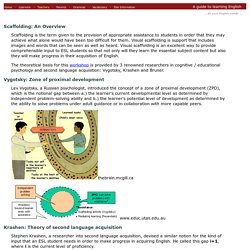

ESL workshop: Scaffolding theory. Scaffolding: An Overview Scaffolding is the term given to the provision of appropriate assistance to students in order that they may achieve what alone would have been too difficult for them.

Visual scaffolding is support that includes images and words that can be seen as well as heard. Visual scaffolding is an excellent way to provide comprehensible input to ESL students so that not only will they learn the essential subject content but also they will make progress in their acquisition of English. The theoretical basis for this workshop is provided by 3 renowned researchers in cognitive / educational psychology and second language acquisition: Vygotsky, Krashen and Bruner. Vygotsky: Zone of proximal development thebrain.mcgill.ca www.educ.utas.edu.au Krashen: Theory of second language acquisition Stephen Krashen, a researcher into second language acquisition, devised a similar notion for the kind of input that an ESL student needs in order to make progress in acquiring English. What Is Bruner's Scaffolding Theory? (with pictures) 6 Scaffolding Strategies to Use With Your Students.
What’s the opposite of scaffolding a lesson? Saying to students, “Read this nine-page science article, write a detailed essay on the topic it explores, and turn it in by Wednesday.” Yikes! No safety net, no parachute—they’re just left to their own devices. Let’s start by agreeing that scaffolding a lesson and differentiating instruction are two different things. Scaffolding is breaking up the learning into chunks and providing a tool, or structure, with each chunk. Simply put, scaffolding is what you do first with kids. Scaffolding and differentiation do have something in common, though. So let’s get to some scaffolding strategies you may or may not have tried yet. 1.
How many of us say that we learn best by seeing something rather than hearing about it? Try a fishbowl activity, where a small group in the center is circled by the rest of the class; the group in the middle, or fishbowl, engages in an activity, modeling how it’s done for the larger group. Scaffolding Definition. In education, scaffolding refers to a variety of instructional techniques used to move students progressively toward stronger understanding and, ultimately, greater independence in the learning process.

The term itself offers the relevant descriptive metaphor: teachers provide successive levels of temporary support that help students reach higher levels of comprehension and skill acquisition that they would not be able to achieve without assistance. Like physical scaffolding, the supportive strategies are incrementally removed when they are no longer needed, and the teacher gradually shifts more responsibility over the learning process to the student. Scaffolding is widely considered to be an essential element of effective teaching, and all teachers—to a greater or lesser extent—almost certainly use various forms of instructional scaffolding in their teaching. Env. Lenas Språkblogg: Scaffolding. Ett nytt LÄS-år har börjat och jag hoppas att det kommer att göra skäl för namnet.

Då kommer också tillfällena att samtala om det lästa att bli många. ”Språk är människans främsta redskap för att tänka, kommunicera och lära. Genom språket utvecklar människor sin identitet, uttrycker känslor och tankar och förstår hur andra känner och tänker” Lgr11 s.222 Respektfulla samtal i olika sociala sammanhang hjälper våra elever att skapa identitet. Att samtala om en gemensam textupplevelse är ett bra sammanhang. Scaffolding påminner om Vygostkijs tankar om imitationens betydelse där läraren eller mer kunniga kamrater är förebilder. Vad Langer också har gjort för oss är ett litet häfte (booklet) som hon har lagt ut på nätet. Lycka till med byggande av stödstrukturer! Scaffolding – en lathund. Scaffolding (”stöttat lärande”) är ett begrepp som kommer från Lev Vygotskij och Jerome Bruner, båda inflytelsrika forskare inom inlärningspsykologi.

Scaffolding handlar om alla de åtgärder som en lärare kan vidta för att stötta en elevs lärande. Allmänt sett kan man tillämpa scaffolding i alla delar av lärandet: Du kan stötta lärandet genom att välja problem och uppgifter som är intressanta. Du kan stötta genom att tydliggöra lärandemål. Du kan stötta genom att strukturera uppgiften. Du kan stötta genom att följa upp och intressera dig för elevens arbete, problem och resultat. Sex steg i Scaffolding (”stöttat lärande”) Nedan följer en lathund för scaffolding som jag översatt från denna e-bok. 1. Diskutera vad som är målsättningen för kursen. 2. Ta reda på vad de kan och inte kan. 3. Snegla på helheten (lärandemålet) under lärandets gång, men bryt ner lärandemålet i de delar (delfärdigheter, delmål, delkunskaper) du ser att lärandemålet består av.